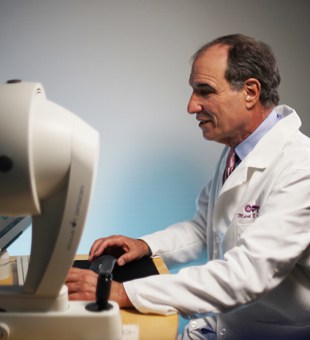Offices in Hayward, Castro Valley & San Jose
The Light Adjustable Lens-What you should expect
The Light Adjustable Lens (LAL) is the first intraocular lens (IOL) whose power can be adjusted after cataract surgery. It is designed to improve how well you see without eyeglasses compared to a standard single focus lens implant.
What is the advantage of the Light Adjustable Lens over other IOLs?
Every other IOL comes in a fixed range of powers. Preoperative calculations are performed to assist the surgeon in estimating the correct lens power for your eye. The measurements are entered into various IOL formulas that estimate the IOL most likely to hit the target that you set with your cataract surgeon. As you might expect, these formulas are not 100% accurate for every patient because of individual differences in anatomy and healing properties of the eye. This is the advantage of the Light Adjustable Lens. Specifically, although we measure the eye preoperatively and use computer programs to calculate the lens power, unlike any other lens, with the Light Adjustable Lens, we can make adjustments to the lens power 3-4 weeks following surgery to fine-tune your vision for unparalleled precision.
Certain factors may make IOL power selection particularly challenging, such as history of prior refractive surgery like LASIK, PRK, RK (radial keratotomy). Others are born with an unusually flat or steep cornea or an extra short or long eye length. For patients in this situation, having an adjustable IOL may be especially beneficial. Those who enjoy monovision (using one eye for distance and the other for near) will enjoy the precision of the LAL because of its ability to fine tune each eye for its target.

How does the Light Adjustable Lens work?
The LAL contains molecules that are light-sensitive. Their position can be adjusted by an external light beam, which alters the shape of the IOL without requiring additional surgery. As the shape of the IOL changes, its power changes, which can adjust for astigmatism, nearsightedness, or farsightedness.
Immediately after the LAL is implanted in your eye at the time of cataract surgery, you must wear special UV-blocking glasses to cover your eyes. You will need to wear these glasses 100% of the time while you are awake except when you take a shower. We provide these glasses for you as part of LAL surgery- one pair that is clear, one sunglass, and one clear with bifocal for reading. These glasses protect the IOL from receiving UV light until the adjustment process is complete. This is about 5-6 weeks.
Most patients will require 3-4 adjustments, although some may require one fewer or one more. The adjustments are performed in the Castro Valley office, where we use a light delivery device to send the beam that reshapes the IOL. It takes approximately two minutes per adjustment. The first customized treatment is typically performed about 3-4 weeks after cataract surgery. Additional adjustments are performed a week apart. When the result is satisfactory, a final treatment is performed, after which the IOL can no longer change or be adjusted. Some patients, such as those with a history of RK, may need more time to stabilize before an adjustment is made. It is critical to wear your UV blocking glasses until the final lock-in treatment is performed. Because the LAL is adjustable postoperatively, patients may elect to have both eyes operated on at the same time.
What is astigmatism?
Like nearsightedness or farsightedness, astigmatism, describes a common type of natural blur in healthy eyes that is corrected by wearing eyeglasses. It results from an inherited, imperfect optical shape of the cornea, the clear front window of the eye. The ideal shape of your cornea is perfectly round, but if it is oblong (like the back of a spoon) instead of spherical, then it will mis-focus the light entering the eye. The more astigmatism one has, the more optically blurry the vision is without eyeglasses. There is no advantage to astigmatism because it adds blur to every focal distance. Eyeglasses and contact lenses can compensate for this corneal shape to correct this blur and to focus eyes with astigmatism.
LAL has a new approach to reducing and possibly eliminating astigmatism. Traditionally, this is done with a special artificial lens that is selected for your cataract surgery called a toric lens implant. Astigmatism can also be diminished using Laser assisted cataract surgery. The Light Adjustable lens has the advantage of being able to provide customized astigmatism correction after your eye has healed and the IOL has settled into its final position. For this reason, the Light Adjustable Lens has the potential to provide the most accurate final outcome.
Will I still need eyeglasses with the Light Adjustable Lens?
No matter which implant is chosen, even if one pays extra for a premium lens upgrade, glasses may be required for certain tasks, especially for reading. Most patients will still need glasses in some situations with the LAL, usually for reading small print. However, the LAL improves the “depth of focus”, meaning that it gives more range of vision than the basic single focus lens. If you choose to set both eyes for distance vision, you will need glasses for reading and other near activities. However, many patients will obtain good range of vision with the LAL if they choose to make one of their eyes slightly nearsighted. Although the LAL does not give as much near vision as a multifocal lens, the LAL does not have rings, so it does not cause additional glare, starburst, or halos at nighttime.
Unlike all of the other IOLs currently available, the LAL allows us to use trial and error to preview various lens powers in front of your eye, like we do when we fit patients for eyeglasses. Some patients, such as those with a large number of RK incisions, have irregular corneas, meaning that the shape of the window in the front of their eye is asymmetric. If your cornea is irregular to the point that you need rigid gas permeable (“hard”) contact lens, the LAL will not be able to correct for all of your aberrations in cornea shape.
Also, no IOL can compensate for having other issues with your eye health, such as glaucoma, macular degeneration, or diabetic retinopathy. Because the LAL does not have rings and does not split light, however, it still can be an appropriate choice for those with co-existing eye problems because it has outstanding optical quality.
What are the risks or disadvantages to the Light Adjustable Lens?
Cataract surgery with the LAL poses no additional medical risk than any other lens implant. The surgery is performed in the usual manner through a small incision. However, some patients are not eligible to receive this IOL, such as if their pupils do not dilate widely enough. Your surgeon will screen you for those conditions at the time of your consultation. You should also be sure that you can comply with full time UV glasses wear for 4-6 weeks postoperatively before you commit to receiving the LAL.
Of all of the special premium lens implants, the LAL is the most expensive upgrade. Health insurance, including Medicare and PPOs, cover the costs of cataract surgery with a basic single focus lens implant. Accordingly, the additional charge for implanting the LAL is not covered by any insurance and must be paid out-of-pocket by the patient.
Remember that the benefit of the LAL is to improve your natural vision utilizing advanced technology to more personalize your visual outcome for your unique lifestyle.
Schedule Your LAL Consultation Today
Your surgeon is a highly experienced ophthalmic surgeon who has helped thousands of patients suffering from cataracts. During a comprehensive consultation at one of his state-of-the-art office Bay Area locations, he can evaluate your cataract and discuss if the Light Adjustable Lens is the best lens option for you. Contact him at 510-886-3937 to schedule your appointment today. Your surgeon has four convenient office locations in Hayward, San Jose and Castro Valley, CA.




